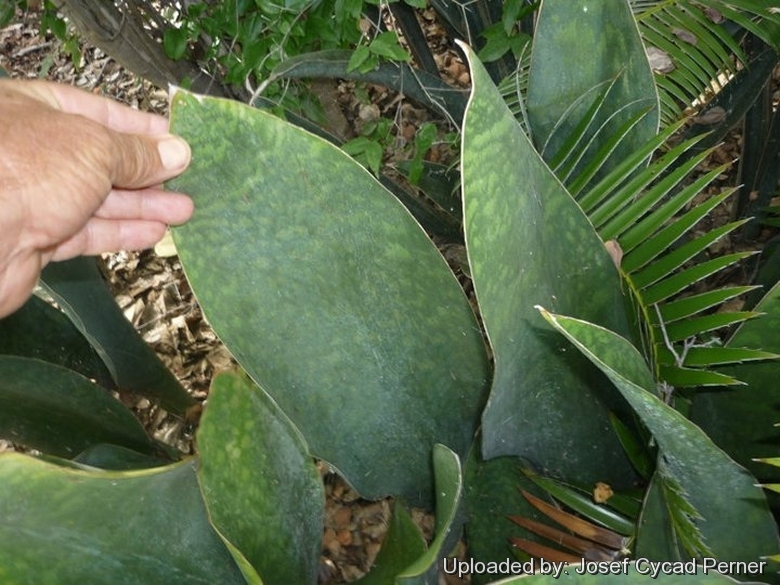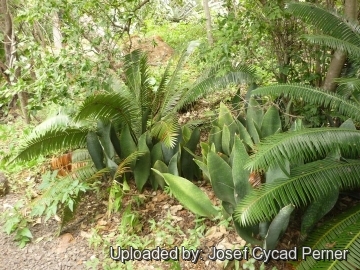




Your support is critical to our success.

Origin and Habitat: Zaire and also in Democratic Republic of Congo, Rwanda and Burundi, Original locality not known. Cultivated for many years under the cultivar name 'Mason Congo'.
Synonyms:
- Sansevieria masoniana Chahin.
ENGLISH: Mason's Congo
Description: Sansevieria masoniana (Mason's Congo) is a semi-succulent acaulescent, rhizomatous plant with characteristic wide leaves that look like beaver's tails or paddles. The leaves are upright, dark green with smudged, light green spots and a unique purple-banded basal sheath. Over time, a single plant forms a a loose but broad clump. Said to be similar to Sansevieria bracteata Baker.
Rhizome: About 4 cm cm in diameter.
Leaves: 1-2 per shoot. Erect, leathery, waxy, broadly lance-shaped, 10-18 cm wide, tip acute, dull blue-greyish green with lighter mottling. There are reports of leaves getting to 180 cm tall though rarely seen quite this big - usually seen at 90-120 cm in height and younger nursery plants that are regularly divided often remain around 60 and not vertically inclined for several years before new taller leaves emerge. Margins fibrous, irregular, wavy chestnut-brown to purple. Surface rough. Basal sheath with purplish transverse bands often below soil level.
Inflorescences: Simple, spike-like, arising from the centre of the plant at the leaf bases if grown in bright light. Peduncle (flower stalk) to 53 cm long, 8 mm in diameter at top, 12 mm at bottom, light green, profusely marked by numerous short purple lines. Raceme with numerous flower clusters fairly close together. 1-2 flowers per cluster.
Flowers: Greenish white, tube 26-30 mm 3 mm in diameter at base, widening to 4 mm at mouth, lobes revolute 24-28 mm long, 3 mm wide. On occasion, i, this plant forms a stalk of white flower clusters.
Blooming season: Flowers can occur anytime of year, but mainly from summer to winter.
History: This plant was collected in what was called the Belgian Congo (then Zaire and now Democratic Republic of the Congo) by Maurice Mason, a renowned plant collector from of Norfolk, England. It was originally introduced as Sansevieria 'Mason's Congo' but was described in 2000 by Juan Chahinian as a species in the Cactus and Succulent Society of America Journal (Volume 72(1).
Notes: The genus Sansevieria numbers about 60 species most of them native of Africa, it has been variously included in the Amaryllidaceae, the Liliaceae and the Agavaceae but is nowadays usually placed in the Dracaenaceae.
Bibliography: Major references and further lectures
1) Urs Eggli “Illustrated Handbook of Succulent Plants: Monocotyledons: Monocotyledons” Springer Science & Business Media, 17 July 2001
2) San Marcos Growers "Sansevieria masoniana" <http://www.smgrowers.com/products/plants/plantdisplay.asp?plant_id=2112>. Web. 06 September 2015
3) B. J. Chahinian “Sansevieria masoniana, a new species from the Congo”. In: Cactus and Succulent Journal. Los Angeles 72(1): 31, 2000.
4) Urs Eggli, Leonard E. Newton "Etymological Dictionary of Succulent Plant Names." Birkhäuser 2004
5) African Plants Database (version 3.4.0). Conservatoire et Jardin botaniques de la Ville de Genève and South African National Biodiversity Institute, Pretoria, "Retrieved 06 September 2015", from <http://www.ville-ge.ch/musinfo/bd/cjb/africa/>.
6) Tropical Africa: J.-P. LEBRUN & A. L. STORK (1991-2012). “Enumération des plantes à fleurs d'Afrique tropicale” et “Tropical African Flowering Plants: Ecology and Distribution”, vol. 1-7. Conservatoire et Jardin botaniques de la Ville de Genève
7) Brink, M. & Achigan-Dako, E.G. “Fibres” PROTA, 2012

Sansevieria masoniana and Dioon spinulosum. Photo by: Josef Cycad Perner
The gallery now contains thousands of pictures, however it is possible to do even more. We are, of course, seeking photos of species not yet shown in the gallery but not only that, we are also looking for better pictures than those already present. Read More...
Cultivation and Propagation: Easy to cultivate, Sansevieria masonianaSN|19026]]SN|31909]], is excellent as a large houseplant, tolerating low light levels and infrequent irrigation. It needs the same care as the standard Snake Plant (Sansevieria trifasciataSN|31909]]SN|19026]]), just make sure you take care in winter to keep rather dry or you can get root rot. It is a very drought tolerant plant. Even this version is prone to suddenly rotting especially if exposed to excessive water, cold or a combination of the two. This is a good houseplant like most or all Sansevierias.
Soil: Use any fast-draining soil that is light and friable (e.g. 3 parts loam to 1 part of pumice).
Repotting: This perennial may also be grown in containers but frequent transplanting is needed to prevent the swelling rhizomes from becoming constricted.
Fertilization: They are fertilized once during the growing season with cactus plant food or half rate of 20-20-20.
Watering Needs: The plants are very drought tolerant and are watered about every other week during heat of summer, allow to dry somewhat between waterings. but keep soil drier the rest of the year. During the winter months they are watered once a month.
Exposure: Dull sun to dappled shade,. Will tolerate low light levels but grows best and flowers if given bright light and even tolerates full sun. Afternoon shade in summer.
Frost Tolerance: Hardy to at least -1 degrees Celsius if kept dry or in a very well-drained soil. Winter frosts will kill the above-ground leaves, but new leaves will emerge when conditions grow warmer as long as the underground rhizome is not frozen
Outdoors: In the garden In mild to tropical climates it prefers semi-shade or shade and it is not fussy.
Pests/Disease: Mealybugs and spider mites.
Use: This is a great succulent companion plant for larger gardens, as well as a good potted plants for interior or exterior use that needs little care. It makes a choice designer's architectural statement.
Propagation: They are propagated by cuttings or by divisions taken at any time. Cuttings should be at least 10 cm long and inserted in moist sand. A rhizome will emerge at the cut edge of the leaf. Variegated cultivars offspring will lack variegation if rooted from leaves.
| Your Actions | |
|---|---|
| Back to Sansevieria index | |
| Back to Dracaenaceae index | |
 |
Back to Succulents Encyclopedia index |
Privacy stantement - Terms and conditions - How to cite - About us - Feedback - Donate



